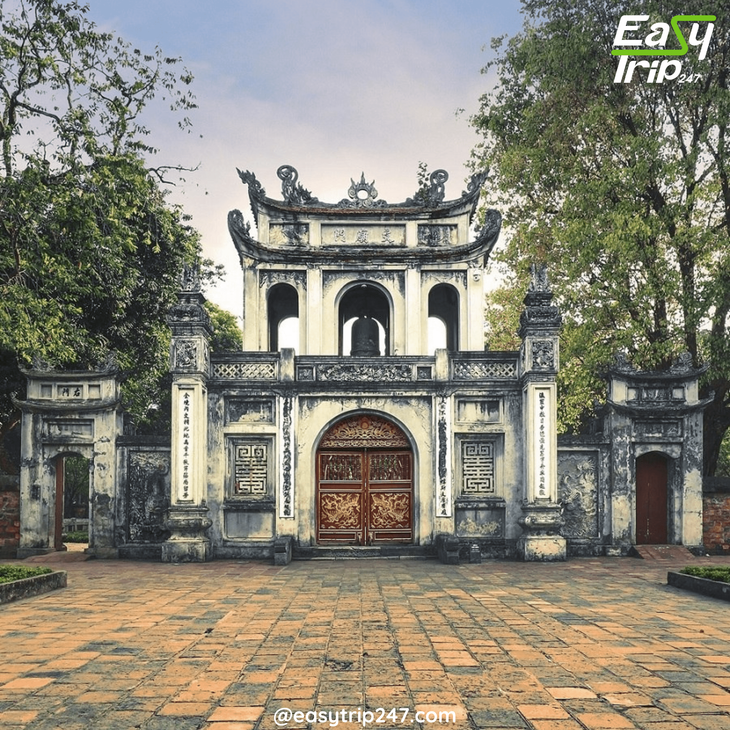The Ongoing Restoration of Hanoi's Temple of Literature: Past and Present
On
23/06/2025Reading time:
1 min
Summary:
Tucked in the heart of Vietnam’s capital, the Temple of Literature Hanoi is more than a tourist destination—it's a living chronicle of Vietnam’s cultural and educational legacy. Built in 1070 as a tribute to Confucius and later transformed into Vietnam’s first national university, the temple is a treasured symbol of the country’s respect for knowledge, wisdom, and tradition.

The restoration of the Temple of Literature Hanoi isn’t simply about preserving bricks and mortar. It is about protecting a sacred narrative, maintaining the delicate artistry of traditional Vietnamese architecture, and preserving one of the few remaining spaces that link modern Hanoi with its thousand-year past. Over the years, the temple has undergone several phases of restoration, each informed by a growing awareness of historical preservation and cultural identity. These efforts are not merely acts of conservation—they are acts of national pride.
Past restoration works began as early as the Nguyen Dynasty, with successive kings ordering repairs and enhancements to maintain the temple’s grandeur. However, some of the earliest documented restoration activities at the Temple of Literature Hanoi occurred in the late 19th and early 20th centuries, particularly during French colonial rule. Despite the colonial government’s interest in preserving certain historic structures, the work done during this era often lacked authenticity. Materials and techniques foreign to the original design were used, which led to incongruities in the architecture and a gradual loss of the site’s original integrity.
The more recent restoration efforts at the Temple of Literature Hanoi have taken a markedly different approach. Spearheaded by the Center for Scientific and Cultural Activities Van Mieu–Quoc Tu Giam, these projects are guided by strict historical accuracy, expert consultation, and traditional Vietnamese craftsmanship. Artisans and historians work side by side to ensure that every detail—from roof tiles and wooden beams to stone inscriptions and garden layouts—reflects the authenticity of its original construction.
One of the most ambitious ongoing projects involves the conservation of the temple’s ancient woodwork. The richly carved altars, beams, and doorways are crucial elements of the temple’s aesthetic and spiritual character. Years of humidity, pests, and pollution have taken a toll, making their careful restoration an urgent priority. Craftsmen use age-old techniques and sustainable local materials to restore the wooden structures, ensuring that the artistry and symbolism embedded in every carving are not lost to time.
In tandem with the architectural work, the conservation of the stone stelae—arguably the crown jewels of the Temple of Literature Hanoi—is a major focus. These massive stone slabs, inscribed with the names and achievements of centuries of scholars, are mounted on the backs of stone turtles, symbolizing wisdom and longevity. Their delicate engravings have weathered over time due to exposure to the elements. Preservationists now use advanced, non-invasive technologies to clean, protect, and document these inscriptions without damaging their historical integrity.
In recent years, digital technology has played a vital role in the restoration of the Temple of Literature Hanoi. 3D scanning, digital mapping, and archival modeling allow historians and architects to recreate detailed blueprints of original structures, even those that have been altered or lost. These tools provide an unprecedented level of precision, enabling restoration teams to better replicate lost elements or predict the effects of future environmental stressors.
But restoration is not just physical—it’s also about renewing relevance. As part of its cultural revitalization, the Temple of Literature Hanoi now serves as a dynamic educational and cultural hub. Restoration efforts have included the addition of interpretive signage, improved pathways for accessibility, and digital guides in multiple languages. These enhancements make the site more welcoming for global visitors while preserving its solemn character for local pilgrims and scholars.
Sustainability has also become a cornerstone of modern restoration strategies. The Temple of Literature Hanoi is situated in a bustling urban area that faces modern threats such as air pollution and rising visitor foot traffic. Planners now prioritize environmentally conscious practices, such as using breathable building materials, incorporating green spaces for natural cooling, and limiting vehicular access to reduce emissions around the temple grounds. These measures ensure that the temple not only survives but thrives in the heart of modern Hanoi.
What makes the restoration of the Temple of Literature Hanoi particularly compelling is the collaboration it fosters. Vietnamese artisans, academic institutions, government bodies, and even international organizations such as UNESCO and foreign cultural funds have contributed to the temple’s preservation. This cooperative spirit reflects a shared recognition of the temple’s global value—not only as a Vietnamese treasure but also as a testament to humanity’s shared reverence for learning and tradition.
Even local communities play a key role in safeguarding the Temple of Literature Hanoi. Educational programs bring students to the temple to learn about its history and participate in mock Confucian ceremonies. Local volunteers help with awareness campaigns, clean-up efforts, and cultural programming. By engaging the public, restoration becomes a shared mission rather than a distant government task, fostering a deeper emotional connection between the temple and the people of Hanoi.
Looking ahead, the restoration of the Temple of Literature Hanoi is expected to evolve with changing times. Climate change, increasing tourism, and urban development pose new challenges, but also provide new opportunities. The temple’s stewards are now developing smart monitoring systems to track humidity, temperature, and air quality in real-time. These innovations will help protect sensitive materials and anticipate maintenance needs, allowing the temple to adapt to 21st-century realities without compromising its historical soul.
For travelers and history enthusiasts, visiting the Temple of Literature Hanoi during this exciting period of restoration offers a unique experience. Not only can you admire the traditional architecture and peaceful courtyards, but you can also witness living history in the making. The process of renewal adds a fascinating layer to your visit, making the temple feel even more alive—an ancient site continually redefined through care, commitment, and creativity.
In many ways, the Temple of Literature Hanoi mirrors the spirit of Vietnam itself—resilient, reverent, and always reaching forward without forgetting its roots. The ongoing restoration of this sacred place is more than preservation—it is a celebration of heritage, a promise to the future, and a glowing tribute to the enduring power of education. Whether you're a local Hanoian or a first-time visitor, walking through its carefully restored pathways is a reminder that history is not just behind us—it is also being written right now.
Design Your Tour Today And Get A Quote. Contact Us Here: +84.975.504.825
Source: Easytrip247 Team compiled.
